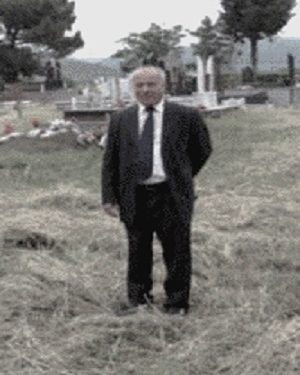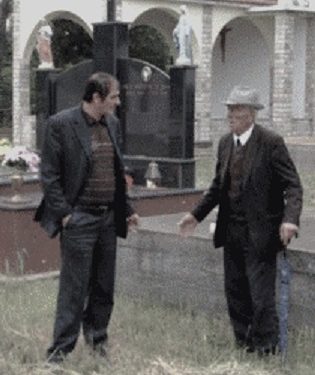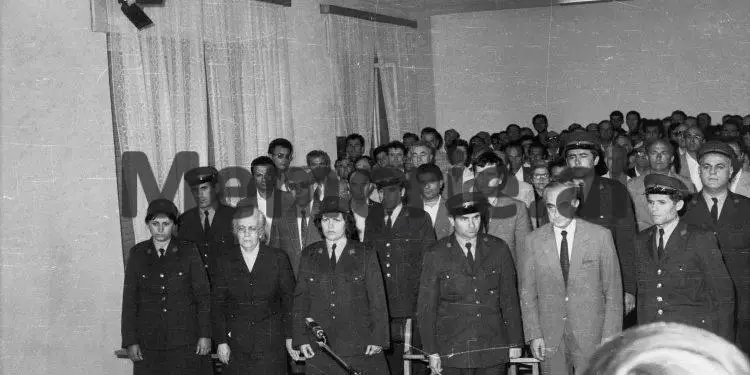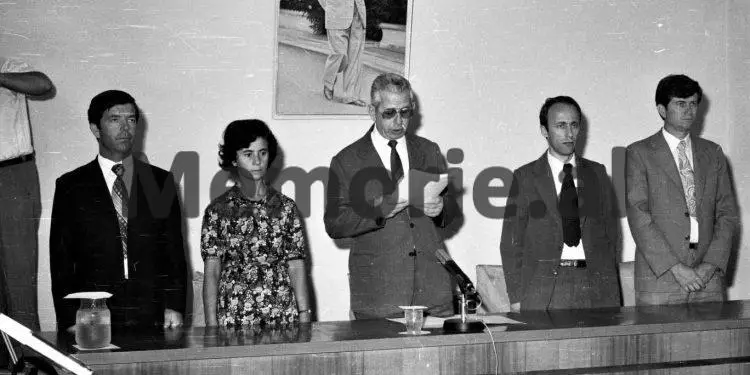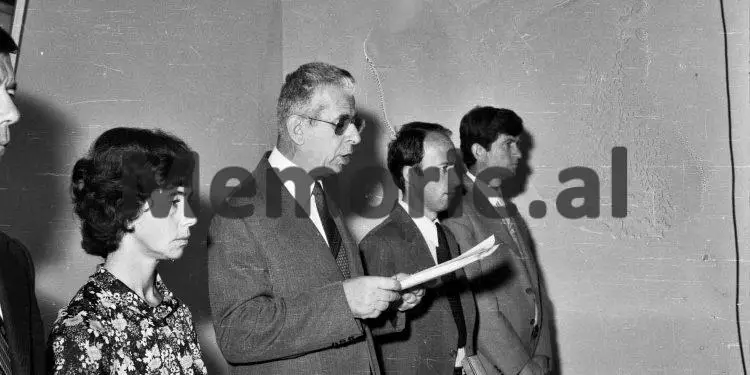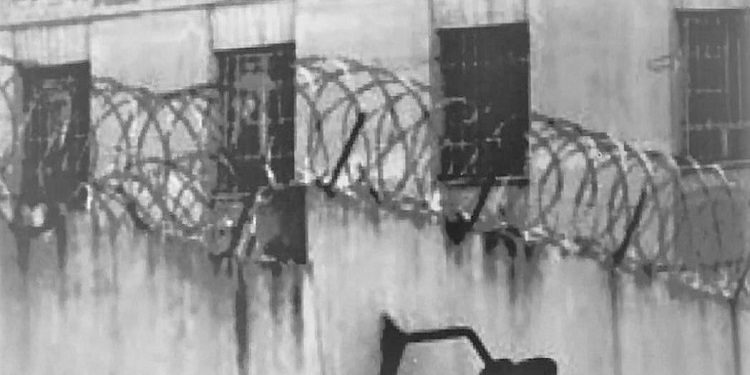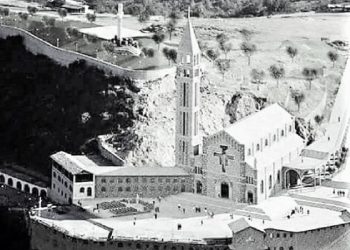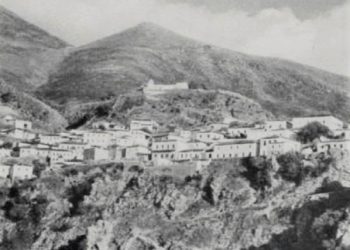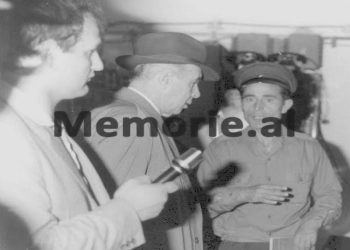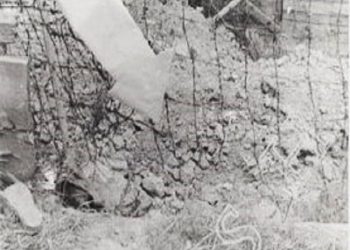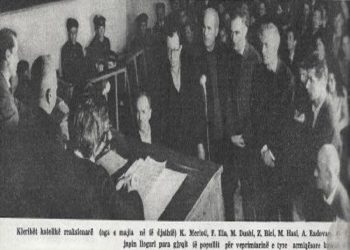By Ermira Isufaj
The rare confession of Gjet Tarazhi: “What Dashnor Mamaqi told me in prison and the conversation with the son of Mehmet Shehu, when he came to look for the remains of his mother, Fiqrete”?
Memorie.al / Zejmeni, is a village approximately 10 km. away from the city center of Lezha and, to get there, it was not an easy journey. Not only a matter of infrastructure, but also the positioning of the cemeteries in the area, in the depth of the municipality of Shënkolli, where if it were not for the orientation of the indigenous residents, arriving at the destination could have turned out to be a failed attempt. Once upon a time, that cemetery was the last residence of some of the most prominent personalities of the time, including the wife of former Prime Minister Mehmet Shehu, Fiqrete. But, this truth, few people knew, except for the cemetery guard, Ndue Tarazhi.
He was the first person to whom this fact was secretly confessed, by a police officer, during the exchange of tobacco, as is customary, from those areas…! This policeman accompanied the body of Fiqrete Shehu, along with three other cars, the day he was brought to Zejmen in Lezha.
Today it is the son, Gjeta, who tells us the event, which was naturally discussed that evening in the Tarazhi family, without leaving the walls of the house. Because the entire formal ceremony had to be performed in complete secrecy, while the cemetery was closed for three days.
It served as the last residence for the individuals who were serving the sentence in the nearby prison, who were all men, and this is information that comes from the protagonists of the co-sufferers of the time.
One of them, the son of the cemetery guard, and former convict in a cell with Dashnor Mamaq, Gjete Tarazhi, once a ship captain by profession, tells us about his memories of the days in the cell with Mamaq and his worries for his daughters, as well as for the “burial” ceremony, with a stone on the grave and a bottle with a number on it, of Fiqrete Shehu.
While Pjetër Zefi, the oldest resident of the village, tells about the unexpected meeting with Skënder Shehu, while the historian Pal Trashaj, speaks from the perspective of the researcher, about this event that happened in 1988, where the formal ceremony was carried out in complete secrecy, with the sole aim of hiding the remains of Fiqrete Shehu.
Mr. Gjet, you are a resident of Zejmen, but unfortunately you have also tried its infamous prison, what is your story?
My name is Gget Ndue Tarazhi. I was born and raised here in Zejmen of Lezha. I had a difficult life, especially after I was convicted by the communist regime, on the charge of trying to escape. I ran the ship “July 10”, that’s what it was called. We only patrolled the waters of the Adriatic.
The way the system worked then, the moment a deviation from the border of the Albanian sea waters was detected, even though every coordinate was studied, because no movement was made without permission and a special order, a slip was enough for them to consider the story as an attempt escape.
I was sentenced in 1976. I have always talked about the years in prison with nostalgia, because I call myself lucky, that I was able to be in a cell with Dashnor Mamaqi, for a full five years, we slept on the same mattress. Then, there in prison, I got to know Todi Lubonja, Kasem Trebeshina, etc., who was well-known, figures at the time.
What memories do you keep from Dashnor Mamaqi?
In Ballsh prison, our cell was called; “revisionist cell”, that is, we were the most dangerous group, and therefore we had a more prominent place than the others. I was the youngest, together with Alajdin Kapo, Hysni Kapo’s nephew.
For Dashnor Mamaq, I have the greatest memories and respect, as he was a special person, above all, very smart. He spoke to me openly about his worries, more about the concern he had for his daughters. In a way, he seemed to feel guilty, for the consequences they had…!
Cosette had a weak point, especially due to the fact that her husband had separated her, due to biography issues, that is, because of Dashnor’s imprisonment. She was interned in Vlora, while the other girl was an operator and worked in Tepelena.
The lover was a closed nature, as he cried about his troubles, mainly for his family, his daughters. Also, he was among the most informed people there in the prison, he read all the time. The fact that Dashnori was claimed to have been one of the most prepared people in the government of Enver Hoxha and all the senior leadership of that time was also discussed in prison by other intellectuals.
He died in the prison of Zejmen, to be buried later in the village cemetery, right?
Dashnori died in the prison of Zejmeni, which belongs to the municipality of Shënkolli. My father was a cemetery guard and gravedigger whenever needed. After the event was recorded in the prison register, Dashnori was not buried, but rather buried…! Because he was thrown into a pit, where only a plaque was placed on the grave and a bottle with no. 13, the number he had kept as a prisoner, during the years of his sentence.
I remember it very well, since we slept on the same mattress for five years in a row. It was a very sad event, because the whole family was scattered in deportations, in different districts of Albania, he was buried by a prison employee, while my father helped during the process, that’s why I’m obsessed, when he told me later, when he got home. This happened after I was released from prison…!
Being the son of the keeper of the cemetery of Zejmen, were you aware of the fact that Fiqrete Shehu was later buried in that place?
No one knew this fact, except my father, as he was told in confidence by one of the employees of the Tirana prison, who accompanied the corpse that day…! Whoever entered these cemeteries, to perform the funeral ceremonies or to remember the relatives who passed away, did not know that the wife of Mehmet Shehu was buried there.
What did your father tell you about this event?
Zejmeni is almost a small village, with about 700 inhabitants. The village cemetery was designed for prisoners who passed away in the Zejmen prison, which had only men. And I say this with full responsibility, as I was not only one of the co-sufferers there, but also a resident of the area.
This was a small prison, divided into three buildings, one for dignitaries, one for prisoners from the ranks of the army or the Ministry of Defense, and the other for ordinary people, convicted of more ordinary crimes.
So, the fact that there were only men, while the village cemetery was below, that is, for ordinary residents, complicates the situation…! That day, three cars with Tirana license plates arrived and they were prison employees, as well as some people from the State Security.
The one who was the guard was immediately taken out of the cemetery and the whole place was surrounded, while the cemetery was closed for three consecutive days. Everything was done in secret, while the father, being an employee, watched from nearby.
You say that the cemetery was closed for three days…?! Didn’t this arouse suspicion or curiosity among the inhabitants of the village?
Serving as the last residence for convicted persons, who passed away in prison, there was no daily loss of life…! This prison was small in terms of its size, the number of convicts, so this situation did not stand out.
How did you find out that Fiqirete Shehu was being buried there?
The whole situation was well studied and the goal was only one: the disappearance of Fiqrete’s remains. Because, being a cemetery for convicts in the prison of Zejmen, who were only men, it could not be understood that a woman was also laid to rest there…! My father explained everything to me in detail and, a few days later, I went myself and saw the place up close.
Since the cemetery was closed for three days and the process was carried out in secret, even in my opinion, they did not want to know whether the process would be carried out at night or during the day, the father learned this fact on the first day when the prison employees they came there and one of them, a policeman, exchanged a cigarette with the father, and secretly, in good faith, you had told him that Fiqrete Shehu had died and they wanted to bury him here…! If he would tell, the consequences were known, so the news was immediately isolated from our family.
What was the reason that the wife of the former prime minister of the country was buried in Zejmen of Lezha, while she died in the prison of Tirana?!
They brought her body from Tirana, right here in Zejmen, not to know where her bones rested…! It is understandable, this was a cemetery only for the convicts of the Zejmen prison, who were all men, and it could not occur to the person that there was also a woman there.
As in the case of Dashnor Mamaqi, Fiqretja also had a stone on her head and a bottle with a number inside, to enable identification years later, when any of the family members would seek her to exhume her.
After Dashnor Mamaqi, Fiqrete Shehu, another well-known person, like the Danish countess, Ollga Libohova, rested for years in the same place, right? Was this a coincidence?
We have heard many stories about Ollga, not only that she has been a resident of the village for years, as an internee in the Zejmeni camp of Lezha, located further away from the prison. She lived there for many years, until the day she died. She was a noble woman with a wide culture.
This is what the oldest residents of Lezha still say today, as it has left behind very beautiful memories. Unlike Fiqrete’s case, she was laid to rest in the Zejmen cemetery, because it was the closest place to the house where she had lived, while her husband had died many years ago and the family was exiled and scattered.
Pjetër Zefi: “How did Skënder Shehu find his mother’s remains”?
Being a small village, with few families, it is not difficult to find the point of connection with what today can be among the oldest people of Zejmen of Lezha. Pjeter Zefi, is in his 90s, and one of the elders of the area, living closer to the Zejmen cemetery.
He learned the story of the burial of the wife of former Prime Minister Mehmet Shehu after the fall of the communist system, a few years later, on the very day when he met Mehmet Shehu’s second son, Skenderi…
Peter, how did you meet the son of former Prime Minister Mehmet Shehu?
It was a coincidence to meet him…! He looked a lot like his father. After introducing himself to me as the son of so-and-so, he said: “Our mother died in prison, we have information, but not sure, that she is here in the Zejmen cemetery.” He asked me if I could accompany him to the house of the cemetery guard, Ndue, Gjeta’s father, and since our house was close, I took him to him.
Did he look worried?
On the way, we had a short chat. He had spent years in prison and it was not an easy life. He told me that he was not sure if he was there, because if he had been different, he would have taken the pickaxe himself and, together with his brother, Bashkimi, would have exhumed the remains of his mother himself.
Therefore, after asking the Tirana prison if any register was kept with the data on Fiqrete’s death, he did not receive accurate information. They had asked many acquaintances, ex-prisoners and, according to their words, they had been told that Fiqretja was buried in Zejmen, in the cemetery for convicts who died in prison, all of whom were men.
So, Skënder Shehu did not come directly to Zejmen, to take the remains of his mother?
They had also searched in other cities, in cemeteries that had been close to prisons, or in those places where unidentified bones had been found over the years. Fiqirete’s family members did not know where her bones were resting, so they came to ask in the village, after they had received directions. I took him to the watchman’s house, and he then showed him the exact location.
What was their experience?
After the location was specified, Skenderi came next, together with his brother, to exhume Fiqirete’s remains. It was a simple and touching ceremony, because the boys were not meeting their mother forever.
Historian Pal Trashaj: “We didn’t know that Fiqiretja rested here”!
The burial of the remains of Fiqirete Shehu, in the Zejmeni Cemetery in Lezha, not because he is among the residents of the area, but also considered from a research point of view, for Pal Trashaj was among the events that was kept isolated for years.
It took the “hour” of the overthrow of the dictatorship system, for the truth of the burial of the remains of the wife of former Prime Minister Mehmet Shehu, after she died in Tirana prison, to come to light and become known, especially after the village spread the news that the sons of Mehmet Shehu had come to exhume the remains of their mother.
As far as I have known it as an event, in my point of view, all these attempts to destroy the remains of personalities of the Fiqrete series have been empty “tribbles” of that system. However, the attempt was clean; they should not have left a mole…!
Therefore, Fiqretja was also brought to this cemetery, which served for convicts who died inside the prison of Zejmen, which was only for men. Who would have thought that a woman, like that of former Prime Minister Mehmet Shehu, would be buried in such a cemetery…?!
We, as residents of the area, have never known that Fiqiretja rested there, because there were other cemeteries below, for the residents of the village. This is called the Gajush cemetery, of Zejmeni in Lezha, that is, it was for the convicts in prison. Therefore, in order not to find out the location, lost places were chosen, to disappear the traces.
If Mehmet’s sons had correct information, they would not have asked where they could look for their mother’s remains. While the rest of Dashnor Mamaqi and the Danish countess, Ollga Libohova, are part of the coincidence, the fact that they came after the sentence in prison and life in the internment camp, so their last apartment was there,” Trashaj concludes his story. Memorie.al




